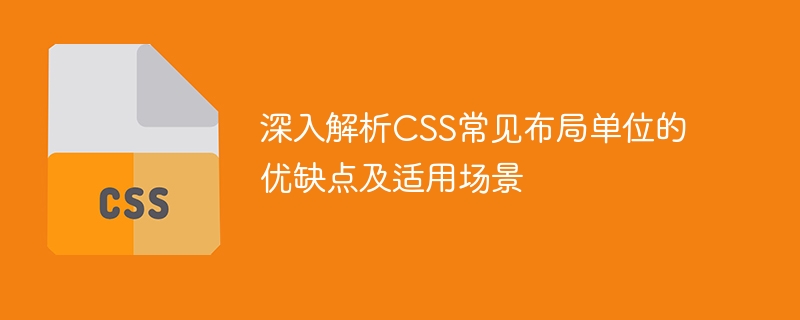Home >Web Front-end >CSS Tutorial >An in-depth analysis of the advantages and disadvantages of common CSS layout units and applicable scenarios
An in-depth analysis of the advantages and disadvantages of common CSS layout units and applicable scenarios
- WBOYWBOYWBOYWBOYWBOYWBOYWBOYWBOYWBOYWBOYWBOYWBOYWBOriginal
- 2024-01-05 14:21:00873browse

In-depth analysis of the advantages, disadvantages and applicable scenarios of common CSS layout units
Article length: 1500 words
Introduction:
In front-end development , CSS layout is a crucial part. Layout units can affect the appearance and adaptability of the page. In CSS, common layout units include pixels (px), percentages (%), viewport units (vw, vh, vmin, vmax) and flexible layout units (rem, em), etc. This article will provide an in-depth analysis of the advantages, disadvantages and applicable scenarios of these common layout units, and provide specific code examples for readers' reference and practice.
1. Pixel (px)
Pixel is one of the most common and commonly used layout units. In CSS, it represents the physical pixel size relative to the monitor screen or device screen. Its advantages are as follows:
- Precise control: The pixels are fixed and the size and position of the elements can be precisely controlled.
- Good browser compatibility: all browsers support pixels as layout units.
However, pixels also have the following shortcomings:
- Not adaptable to different devices: The pixels are fixed and cannot adapt to the size according to different devices, resulting in a poor user experience.
- Inflexible: Screen sizes are different, and the same pixel value may appear in different sizes and proportions on different devices.
- High-resolution screen blur: For high-resolution screens, pixel units may cause the page to be blurry.
Applicable scenarios:
For some fixed-size elements, such as icons, borders, etc., you can use pixels as the layout unit. Code example:
.icon {
width: 16px;
height: 16px;
}2. Percent (%)
Percent is a relative unit, which represents the size relative to the parent element in CSS. Its advantages are as follows:
- Relative layout: Percentage can perform relative layout according to the size of the parent element, with a certain degree of flexibility.
- Adaptive: Adaptable layout can be made according to the screen size of different devices.
However, percentages also have the following disadvantages:
- Percentage has no effect for elements with no width set.
- For multi-level nested elements, size calculation is relatively complex and error-prone.
Applicable scenarios:
For relative layout of element width, such as the grid system in responsive layout, you can use percentage as the layout unit. Code example:
.container {
width: 100%;
}
.column {
width: 50%;
}3. Viewport units (vw, vh, vmin, vmax)
The viewport unit is the layout unit relative to the browser viewport size, where vw represents the percentage of the viewport width , vh represents the percentage of the viewport height, vmin represents the percentage of the smaller value of the viewport width and height, and vmax represents the percentage of the larger value of the viewport width and height. Its advantages are as follows:
- Responsive layout: The viewport unit can be laid out according to the viewport size of different devices to achieve truly responsive design.
- Does not depend on the parent element: The viewport unit does not depend on the size of the parent element and can independently control the size and position of the element.
However, the viewport unit also has the following shortcomings:
- Compatibility issues: For some old browsers, such as IE9 and below, the viewport is not supported unit.
- In some cases, using viewport units may cause the element size to exceed or overflow the viewport, so you need to pay attention to adjustments.
Applicable scenarios:
For situations where the size and position of elements need to be adjusted according to the viewport size in responsive layout, you can use the viewport unit as the layout unit. Code example:
.container {
width: 100vw;
height: 100vh;
}
.column {
width: 50vmin;
height: 50vmin;
}4. Flexible layout unit (rem, em)
Flexible layout unit is a layout unit relative to the font size of the root element (rem) or the font size of the parent element (em). Its advantages are as follows:
- Relative layout: Flexible layout units can perform relative layout according to font size, which has a certain degree of flexibility.
- Scalability: In responsive design, the entire layout can be expanded by adjusting the root element font size.
However, flexible layout units also have the following disadvantages:
- In some cases, using flexible layout units may cause the element size to exceed or overflow the container, and you need to pay attention to adjustments. .
Applicable scenarios:
For situations that require layout relative to the font size, you can use flexible layout units as layout units. Code example:
.container {
font-size: 16px;
}
.column {
width: 2rem;
height: 2rem;
}Conclusion:
By deeply analyzing the advantages, disadvantages and applicable scenarios of common CSS layout units, we can choose the most appropriate layout unit according to specific needs. Pixel units are very convenient for fixed layout and precise control of size, percentage units are suitable for relative layout and responsive layout, viewport units are very practical for achieving truly responsive design and do not rely on the size of the parent element, and elastic units are very convenient. Layout units are used when laying out relative to font size. In actual development, we can integrate various layout units according to needs and use them flexibly to achieve better page layout and user experience.
The above is the detailed content of An in-depth analysis of the advantages and disadvantages of common CSS layout units and applicable scenarios. For more information, please follow other related articles on the PHP Chinese website!

